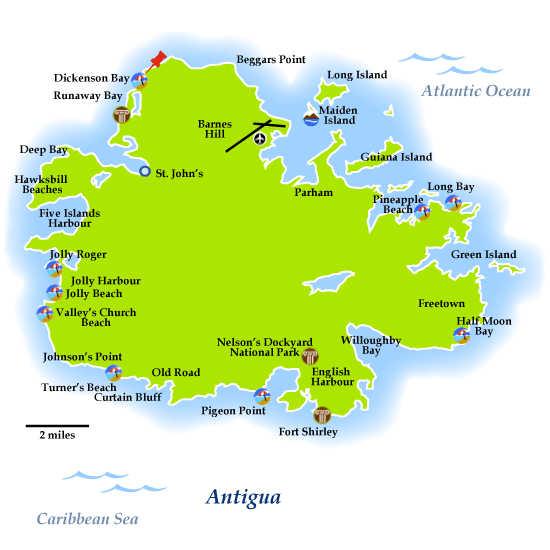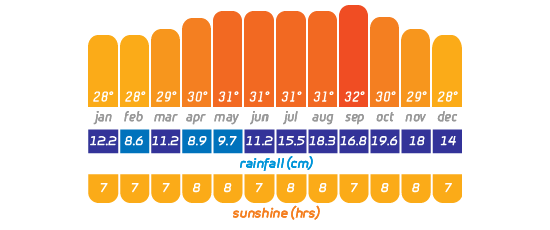Currency & Credit Cards
Currency:
The Eastern Caribbean dollar (EC$) floats on the international exchange and is currently rated at approximately GBP1.00 = EC$3.82 / US$ 1.00 - EC$ 2.70. The US dollar is generally accepted in any business used to dealing with tourists throughout the island, but if you are going off the beaten track then it is advisable to always have some local currency to hand.
Credit Cards:
Most of the major credit cards (and some debit cards) are accepted anywhere that deals with tourists on a regular basis. However, do not expect local bars or small local restaurants and businesses to accept them. When dining out it might be a good idea to double check payment methods in advance. It is worth noting that certain credit cards may attract an additional charge or may simply not be accepted.
Diving
Whilst Antigua may not rank among the top Caribbean islands for scuba diving, but it can work well as a taster or as a complement to other activities on island. There is reasonable variety for you to dip into, on the reefs and coral gardens and a few walls and wrecks. Antigua is a particularly good option if you are learning to dive, if you are on island for other reasons and want to get in a few dives or if you traveling with non-divers and do not want to spend whole days at it. The main dives sites are located to the south and west of the island (there are some reefs to the north, including Boon’s Reef, which is used for training). However, most dive trips usually head south.
There is generally not a very strong current around Antigua. And, with the white sandy bottom and clean water the visibility is generally very good, often up to 100 feet. The reefs are in reasonable condition, but some are very close to the surface, which means some have been damaged by hurricanes and others have lost their larger fish, so for the better marine life you have to go farther offshore. Antigua sees the usual reef life that you would expect in the Caribbean, sponges, elkhorn and staghorn, even occasional black coral, and reef fish including parrot fish, angel fish, snappers and chromis. Occasionally you will see larger and ocean-going creatures such as rays, barracuda and nurse sharks. Please do not step on or touch the coral - which live organisms and an integral part of the reef eco-system. There is plenty of good snorkeling around Antigua and there are beaches that are particularly good for it and of course there are day sails that include a visit to a reef (usually Cades Reef) as part of their trip. The nearest hyperbaric/decompression chambers to Antigua are located on the islands of Saba and St Thomas in the US Virgin Islands.
Geography
Tobago lies 11 degrees north of the equator and just 22 miles north-east of its sister island Trinidad. The island is not volcanic in origin, rather it is made of rubble that has been pushed up by the movement of the Caribbean tectonic plate on its eastward journey along the northern side of South America and against the Atlantic plate. The island lies at a slant from southwest to northeast, with the higher, forested land in the east, topping 1860ft at the island’s highest point, Pigeon Peak. The lower, western end of the island has become clad with coral limestone as the sea has risen and fallen around it over the millennia. At 26 miles long and 7 miles across at its widest point Tobago is 116 square miles in size.
History
Human habitation is thought to date back 4500 years when various Indian tribes settled the coastal areas in small groups. The earliest were the Siboney (Stone People) followed by Archaic Age Indian and then the Arawaks. The Arawaks new the island as "Wadadli" – which today is the name for the local Wadadli Beer. The Caribs followed the Arawaks and it is they who gave their name to the whole Caribbean region. The island was “spotted” by Columbus when he passed by on his second voyage to the New World in 1493. Columbus named the island Santa Maria de la Antigua. Over the next 100 years the island was used as a stopover by the Spanish and by the increasing numbers of adventurer and other seafarers. The islands natural harbours were a great attraction. The Spanish never settled permanently. It was not until 1625 that there was a permanent European settlement commencing from British colonizers who had come from nearby St Kitts.
The island was fought over for a long while. Initially with the Caribs who were keen to keep the Europeans out of the area. And then between the Europeans themselves. But, with the exception of a short period of occupation by the French, Antigua remained in British hands until it was granted independence in 1981. Because of its strategic value and excellent harbours, Antigua became a very important base for the British in the area (along with Jamaica and Barbados). The result was that it became one of the most heavily fortified places on earth. Visitors can still see abandoned forts all over the island (at one stage there was a defensive structure every mile and half around the whole coast). The most famous historic area is Nelson’s Dockyard in the south-east, named after the famous British admiral who spent some time there in the 1780s. It is the only example of a restored Georgian naval dockyard in the world.
Like many of the other Caribbean islands, Antigua started to grow sugar in the Eighteenth Century. Sugar cultivation was dependent on slave labor and so large numbers of Africans were forcibly shipped across the Atlantic. Their descendants make up the bulk of Antigua’s population today. Sugar was never a huge success. When slavery and then the system of Apprenticeship were abolished in 1834 and 1838 it folded fairly quickly. The island went into decline for decades. And, in parallel with political movements all over the Caribbean, Antigua began to take charge of its own political destiny at the beginning of the 1900s. Antigua, Barbuda and Redonda took their independence from Britain in 1981.
Local Taxes
All hotel accommodation is subject to a 8.5% room tax and a 10% service charge as well. Tour operator packages prices will includes these charges as will accommodation booking agents and websites. If you are booking direct, make sure you calculate this in when pricing up your holiday.
Travel Safety
Please exercise the same safety precautions you would at home. Crime against tourists is very low but be sensible when out and about.
Visa’s and Entry requirements
UK, Canadian and US citizens will need a valid passport which is valid for 6 months and a return air ticket. Most European passport holders do not require a visa and can enter on a valid passport. Please check with your nearest Antigua High Commission or visit their website.
Weddings
Antigua and Barbuda was made for tropical romantic weddings and idyllic honeymoons. There is no waiting period required for your wedding and as long as all the paperwork is in place you can easily be married in one day. Your wedding ceremony in Antigua, can take place anywhere that you choose. And, as you would expect, you can choose from a whole range of venue options when marrying in Antigua, from barefoot on the beach to classical in the cathedral. The process for getting married in Antigua is relatively straightforward, the venues are many and varied and the cost can be a fraction of a wedding in the UK. For more information on getting married in Antigua, please see our "Weddings" page.


